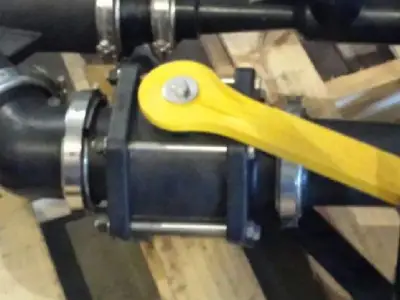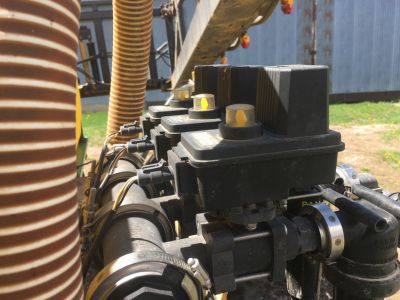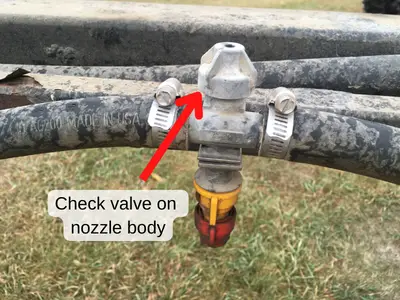Agricultural equipment has come a long way in terms of efficiency and precision. One crucial component that plays a pivotal role in this is sprayer valves. In this comprehensive guide, we will delve into the world of sprayer valves, understanding their various types, factors to consider when choosing the right one, and the benefits they offer to modern agriculture.
RELATED: Parts of a Sprayer and Their Function
Understanding Sprayer Valves
Without valves, a sprayer is very hard to control. While the sprayer pump provides the flow, valves are what facilitate the different functions of a sprayer. You can direct flow to different boom sections, agitate the liquid in the tank, and increase or decrease the sprayer’s output.

Different types of valves are required to accomplish all of these various functions. They vary in size, type, and function. Let’s go ahead and examine how valves differ and why.
Sprayer Valve Sizes
There are typically several different sizes of valves used on a sprayer. From large on/off valves on the tank outlet to small drain valves on a strainer. The reason there are so many different sizes is that the amount of liquid that needs to pass through each valve varies depending on the specific spot in the sprayer plumbing.
The largest valves will be used as tank fill valves and in the main suction line from the primary outlet on the tank that feeds liquid to the sprayer pump. The size of these valves used will vary depending on the sprayer but the outlet valve on the tank should have a fluid path (inside diameter) at least as large as the inlet of the pump.
Various sizes of valves are used throughout the rest of the sprayer. Again, the size of the valve will be dependent on the flow that is required for that specific fluid path. If you are building a sprayer, be sure to review this guide to help with your plumbing.
Sprayer Valve Types
The world of sprayer valves is diverse, with each type of valve serving a different purpose. They differ both in the mechanism that is used to open/close them as well as their intended purpose. We can separate sprayer valves into different categories based on their characteristics and functions
Ball Valves
Manual on/off ball valves are an extremely common component on most sprayers. As the name implies, these valves have a ball inside that is connected to the handle. The handle turns the ball in the seat to shut off the flow. They can be manual valves that are operated by hand or they can be actuated by an electric, hydraulic, or air-driven motor.

Quarter turn, polypropylene ball valves are one of the most common types of valves used on sprayers. They are chemical resistant, don’t rust, and they are durable.
Electronic Valves
Electric valves are pivotal components in precision spraying applications. They allow the operator of a sprayer to remotely control the flow of fluid in the system. These valves can be simply on/off valves that are used to either stop the flow to a boom section or other accessory, or they can be regulating valves.

Boom section control is possible with a set of electronic valves that are mounted together on a sprayer to create a manifold. The boom is divided into different sections that correspond with a valve in the manifold. This provides a more precise application of pesticides, fertilizers, etc. Rather than the entire boom being “on” or “off”, specific sections can be shut off when not needed.
Solenoid Vs Motorized
When it comes to agricultural sprayers there are two primary types of electric valves used: solenoid valves and motorized ball valves. While they are both used to turn on/off valves from the sprayer/tractor cab with a switch, they differ in how they operate.
Motorized valves are typically a much better choice for ag use. They are more durable and the motors will last much longer. However, they do tend to be more expensive. You can read my guide on solenoid vs. motorized ball valves to see which one would be better for your application.
Regulating Valves
Manual Regulating – A manual regulating valve is a mechanically operated valve that controls the flow and pressure of the liquid being sprayed. It is adjusted via a control knob.
The primary function of a regulating valve is to maintain the operating pressure within a system. A manual regulating valve has a bypass that sends excess liquid back to the supply tank.
Electronic Regulating Valves – Electronic regulating valves offer precise control over the rate at which liquid is applied. They are commonly used on large agricultural sprayers and anti-ice sprayers where the rate needs to be adjusted automatically as the travel speed changes.

Unlike manual valves, these are controlled electronically, often through a control console or a remote switch box. These types of regulating valves work in tandem with a flow meter to maintain the desired application rate.
Regulating valves play a crucial role in precision agriculture. If you are interested in learning more about how a regulating valve works with other components to maintain a consistent application rate, then be sure to read this article on automatic rate control setups.
Gate Valves
Gate valves are used in applications where the flow needs to be controlled but not precisely. For example, on a sprayer, you might want to direct a portion of the flow back to the tank to agitate the spray solution. A gate valve allows you to throttle or adjust the amount going back to the tank manually. When you are not spraying, the valve can be opened more to increase the agitation rate.

Gate valves operate by lifting a gate out of the path of the fluid. These valves typically have a wheel on top of a stem that attaches to the gate inside of the valve body.
Three-Way Valves
A three-way valve typically has three ports or connections. These are commonly referred to as an inlet and two outlets, or vice versa, depending on the valve’s function and the system’s design.

Three-way valves are used to control the direction of the fluid flow. This can be crucial in systems where the fluid needs to be selectively directed between different paths, such as directing flow to an inductor tank for mixing.
Check Valves
A check valve is designed to allow fluid (like water, pesticide, or herbicide) to flow in only one direction. It typically consists of a valve body, a seat, and a movable part (often a diaphragm) that blocks reverse flow. They will only open when the system pressure reaches a certain point. This is called the cracking pressure and on a sprayer, it is typically anywhere from 1-20 psi depending on the application.

In sprayer nozzle bodies, check valves are crucial for preventing the dripping of chemicals when the sprayer is turned off or when there’s a decrease in pressure.
Functions of Sprayer Valves
Valves on an agricultural boom sprayer play several crucial roles in ensuring the effective and efficient operation of the spraying system. Here’s a breakdown of their primary functions:
- Flow Control: Valves regulate the flow of the spray solution from the tank through the system. By adjusting these valves, the operator can control the rate at which the liquid is dispensed, ensuring the correct application rate of the product being sprayed.
- Pressure Regulation: They help in maintaining consistent pressure within the sprayer system. Consistent pressure is key to ensuring that the spray is evenly distributed across the boom’s nozzles, leading to uniform application on the crops.
- Section Control: Modern boom sprayers often have section control valves. These allow the operator to control different sections of the boom independently. This feature is particularly useful for minimizing overlaps or skips in areas already sprayed or for avoiding sensitive areas.
- Anti-Drip Function: Valves, especially at the nozzle level, can include anti-drip features. These prevent the solution from dripping when the sprayer is turned off, reducing waste and preventing unintentional application of chemicals on the plants or soil.
- Safety and Relief: Safety valves act as a fail-safe mechanism to prevent over-pressurization of the sprayer system, which could lead to equipment damage or safety hazards. Relief valves open to release excess pressure, maintaining the system’s integrity.
- Mixing and Agitation: Some valves are used to control the mixing and agitation mechanisms within the tank. Proper agitation is critical for keeping the spray solution uniformly mixed, especially when dealing with suspensions or solutions that can settle or separate.
- Cleaning and Draining: Valves also play a role in the cleaning and draining processes of the sprayer. They allow for the controlled release of remaining liquids in the tank and lines, making it easier to perform thorough cleaning, which is essential for sprayer maintenance and preventing chemical residue problems.
Different sprayer valves work together with a rate controller to allow the operator to automatically adjust the sprayer’s output. You can learn more about automatic sprayer control in this guide to electronic sprayer control setups.
Placement of Sprayer Valves
Depending on the sprayer type, there may be several valves on a sprayer. One of the primary uses of manual ball valves in sprayer systems is to control and switch between different accessories or to alter the sprayer’s mode of operation.
Take, for example, an agricultural boom sprayer. Typically, these sprayers are equipped with a high-volume pump. A manifold on the discharge side of the pump with multiple valves allows the pump to perform various tasks simultaneously, based on the operator’s needs.

By opening or closing different ball valves, the operator can direct the flow of liquid to specific parts of the sprayer, enabling it to perform multiple functions. This could range from powering the main boom to operating additional features like agitation, mixing tanks, or recirculation systems.
Electronic valves further enhance the functionality of sprayers. These valves offer the same capabilities as manual ball valves but with the added benefit of remote control. This means that an operator, comfortably seated in the cab of a sprayer, tractor, or truck, can make on-the-fly adjustments to the sprayer’s output.
Selecting the Right Valve
When choosing a valve for your sprayer, consider the following factors:
- Type of Sprayer: Different sprayers have different requirements. High-pressure sprayers might need more robust valves compared to low-pressure ones.
- Chemical Compatibility: Ensure the valve material is compatible with the chemicals you plan to use.
- Flow Rate and Pressure Requirements: Select a valve that can handle your system’s flow rate and pressure.
- Ease of Operation: Consider if you need manual or electronic control based on your operational convenience.
- Durability and Maintenance: Look for valves that are durable and easy to maintain, especially in harsh agricultural environments.
Many types of valves can be used on just about any sprayer. For example, ball valves, gate valves, and check valves don’t care where you use them as long as they are rated to handle your operating pressure and they are made from materials that will hold up to the liquid benign sprayed.
Conclusion
Understanding the different types of sprayer valves and their specific functions is key to optimizing your spraying operations. Whether it’s managing flow, pressure, direction, or simply turning the spray on and off, the right valve can make a significant difference in the efficiency and effectiveness of your sprayer. Always consider your specific needs and the characteristics of your sprayer system when selecting valves.

